|
|
|
Sort Order |
|
|
|
Items / Page
|
|
|
|
|
|
|
| Srl | Item |
| 1 |
ID:
126140
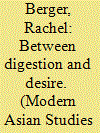

|
|
|
|
|
| Publication |
2013.
|
| Summary/Abstract |
This paper takes up the project of conceptualizing a new history of food in India through an exploration of conversations about food, digestion, desire, and embodiment that took place in Hindi-language publications in early-twentieth century North India. Through an exploration of cookbooks, guides to health and wellness, and food advertising spanning the 1920s to the 1940s, conversations about food preparation, consumption, and distribution come to be revealed as significant anchors of historical, political, economic, and cultural debates about the Indian nation in this period. The centrality of food to conversations that took up the reproduction and regeneration of the Hindu middle class helped to conceptualize an idealized Indian nation[A]. Subsequently, the focus on food advertising imagined the transformation of these citizens into consumers. Moving beyond the colonial fascination with native bodies and tropical constitutions, this paper demonstrates the ways in which the conversations that emerged out of a focus on food in popular culture did the work of envisioning new possibilities for post-colonial embodiment.
|
|
|
|
|
|
|
|
|
|
|
|
|
|
|
|
| 2 |
ID:
126139
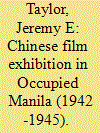

|
|
|
|
|
| Publication |
2013.
|
| Summary/Abstract |
This paper explores the nature of film exhibition amongst the Chinese community in Manila during the Japanese Occupation of that city. Based on advertisements and film listings published in the Chinese-language press of the day (as well as on pre-war records concerning commercial Chinese entertainment in the Philippines), it explores the continuities in film exhibition practice undertaken by various theatre operators within the Binondo area of Manila both before, during, and after the war. The paper suggests not only that such practices represented a quite different trajectory from that experienced in other parts of Occupied Manila, but also that a more thorough exploration of the Manila Chinese during wartime-one which goes beyond questions of mere collaboration and/or resistance-will encourage us to question some of the assumptions that underpin recent scholarship about this community.
|
|
|
|
|
|
|
|
|
|
|
|
|
|
|
|
| 3 |
ID:
126137
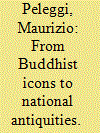

|
|
|
|
|
| Publication |
2013.
|
| Summary/Abstract |
In the mid 1920s Prince Damrong Rajanubhab and George Coedès jointly formulated the stylistic classification of Thailand's antiquities that was employed to reorganize the collection of the Bangkok Museum and has since acquired canonical status. The reorganization of the Bangkok Museum as a 'national' institution in the final years of royal absolutism responded to increasing international interest in the history and ancient art of Southeast Asia, but represented also the culmination of several decades of local antiquarian pursuits. This paper traces the origins of the art history of Thailand to the intellectual and ideological context of the turn of the twentieth century and examines its parallelism to colonial projects of knowledge that postulated a close linkage between race, ancestral territory and nationhood.
|
|
|
|
|
|
|
|
|
|
|
|
|
|
|
|
| 4 |
ID:
126135
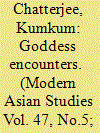

|
|
|
|
|
| Publication |
2013.
|
| Summary/Abstract |
This paper makes a case for exploring the cultural facets of Mughal rule as well as for a stronger engagement with sources in vernacular languages for the writing of Mughal history. Bengal's regional tradition of goddess worship is used to explore the cultural dimensions of Mughal rule in that region as well as the idioms in which Bengali regional perceptions of Mughal rule were articulated. Mangalkavya narratives-a quintessentially Bengali literary genre-are studied to highlight shifting perceptions of the Mughals from the late sixteenth century to the eighteenth century. During the period of the Mughal conquest of Bengal, the imperial military machine was represented as a monster whom the goddess Chandi, symbolizing Bengal's regional culture, had to vanquish. By the eighteenth century, when their rule had become much more regularized, the Mughals were depicted as recognizing aspects of Bengal's regional culture by capitulating in the end to the goddess and becoming her devotees. This paper also studies the relationship of the Mughal regime with Bengal's popular cultural celebration-the annual Durga puja-and explores its implications for the public performance of religion and for community formation during the early modern period.
|
|
|
|
|
|
|
|
|
|
|
|
|
|
|
|
| 5 |
ID:
126144
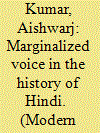

|
|
|
|
|
| Publication |
2013.
|
| Summary/Abstract |
This paper examines the history of 'Hindi'1 as a modern Indian language in Bihar between 1850 and 1900. It looks beyond the North-Western Provinces, hitherto the focus of most studies of Hindi, and issues that were important here but not in Bihar like, for example, the 'Hindi'-Urdu conflict. Instead, it looks at how the ways in which the history of 'Hindi' unfolded in Bihar and was distinct from that in other parts of North India. It demonstrates how the regional languages of Bihar were more crucial to the development of 'Hindi' in this region than standardized 'Hindi', at least until the early twentieth century. A prime focus in this paper is Sir George Abraham Grierson who postulated the theory of an independent 'Bihari' language and collected materials to support it. These materials reflect the continuing popularity of Bihari cultural traditions throughout the nineteenth century despite the avowed support for a standardized 'Hindi' by the colonial government and the intelligentsia of Bihar. They add a dimension to the historical development of 'Hindi' that was distinctive to Bihar. Focussing on this, this paper stresses the part played in the history of 'Hindi' by an agent whose voice was marginalized and later ignored or suppressed in canonical accounts of its development as a modern Indian language.
|
|
|
|
|
|
|
|
|
|
|
|
|
|
|
|
| 6 |
ID:
126138
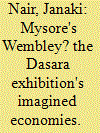

|
|
|
|
|
| Publication |
2013.
|
| Summary/Abstract |
Most scholarly works on exhibitionary practices of the nineteenth and twentieth centuries have focused on the meaning and importance of display, and the cultural bases, and indeed biases, that supported various inclusions and exclusions. The exhibition has usually formed part of a larger narrative of new rituals that were enacted in the modern period to serve, variously, imperial, market or patriotic objectives. Can the persistence with which the Princely Mysore state organized its Dasara Exhibition from 1907 until well after independence be understood solely within these frames? In both its choice of location and its timing, the Dasara Exhibition was organized with dogged insistence, despite its obvious failures. This can only be understood in relation to the larger changes that were envisaged for the economy of the region, as the state attempted to build a supplement, even an alternative, to the princely splendour and pomp that was on conspicuous display. This paper looks at the subtle changes and shifts that occurred during the first half of the twentieth century in exhibitionary practices as they related to both real and envisaged changes within the economy that the Mysore bureaucracy was obliged to bring into being.
|
|
|
|
|
|
|
|
|
|
|
|
|
|
|
|
| 7 |
ID:
126141


|
|
|
|
|
| Publication |
2013.
|
| Summary/Abstract |
This paper charts the linguistic shifts in a popular iteration of the story of Lord Ram, commonly known as the 'Radheshyam Ramayan' (composed in the first quarter of the twentieth century), across four versions of the text published in the devanagari script, between 1939 and 1969. It argues that the author, Radheshyam Kathavachak, likely revised his text over the course of many years, in large part to bring its language closer to suddh (pure) Hindi on the Hindi-Urdu spectrum-a labour that was in the service of the Hindi language movement, if not also Hindu nationalism. Whilst the language in the 1939 printing is a mixed register of Hindi-Urdu, by 1959, the language has undergone a process of 'Sanskritization'. That is, much of the vocabulary of Persian and Arabic origin, and also much vocabulary associated with the Braj tradition, have been replaced with words from Sanskrit. The progressive editing of text also shows a deep concern for the standardization and occasionally, elevation of literary Hindi, and simultaneously, the correction of defects in meter and style. The example of Kathavachak's 'many Radheshyam Ramayans' offers insight into the timing and pace of the Sanskritization of Hindi letters, suggesting that for some, the process may have been more protracted and anguished than is often thought.
|
|
|
|
|
|
|
|
|
|
|
|
|
|
|
|
| 8 |
ID:
126136


|
|
|
|
|
| Publication |
2013.
|
| Summary/Abstract |
Recently we have seen an increasing number of publications, mostly of an ethnographic nature, describing and discussing the significant religious roles and achievements of Thai Buddhist women, not only in the field of Buddhist education, and with regard to their monastic roles, but also in terms of their roles as accomplished Buddhist practitioners. This paper examines the changes occurring in the status and position of women in Thai Buddhist practice. In this regard I focus on the analysis of one of the first widely acknowledged female saints of modern Thai Buddhism: Khun Mae Bunruean Tongbuntoem (1895-1964). Khun Mae Bunruean has obtained her increasing reputation through the advanced meditative achievements which her followers believe she possessed. I use hagiographical accounts of her as a focal point to unravel and examine Thai beliefs in relation to female sainthood in present-day Thai Buddhism. This is done by discussing gendered hagiographical writing against the background of relevant canonical and post-canonical Pali texts that have exerted authority in religious discourses on gender by informing and nurturing Thai religious value systems. This textual research is complemented by the ethnographic examination of Thai Buddhist beliefs and venerational practices which cannot be found in authoritative Pali texts but which still play a significant role in the understanding of the particularities of female saints in modern Thai Buddhism. I do not confine myself to hagiographical accounts and venerational practices directly linked to gender, but also devote some attention to other conspicuous aspects, elements, and expressions of Mae Bunruean's sainthood and her veneration.
|
|
|
|
|
|
|
|
|
|
|
|
|
|
|
|
| 9 |
ID:
126142


|
|
|
|
|
| Publication |
2013.
|
| Summary/Abstract |
The late-nineteenth century in India, usually scrutinized for the emergence of anti-colonial nationalist thought and politics, witnessed broader, and potentially more radical changes in the making and re-making of political subjectivities as articulated within burgeoning vernacular public spheres. Vernacular publics coalesced around the emergence of new communicative forms, the formation of voluntary and political associations, and the restructuring of literary communities. It is within this context I place the writings of Gidugu Venkata Ramamurti (1863-1940). He proclaimed at the turn of the twentieth century that Telugu as a language had to be reformed in order for it to become an appropriate medium for the newly emergent Telugu public spheres. Through his study of linguistics, his commitment to educational reform, and his study of Telugu language and literature, Ramamurti became the spokesperson for a new Telugu that would be able to traverse the boundaries of modern genres of writing that flourished in the colonial era. Fully immersed in linguistic theories of the day, Ramamurti's concerns were primarily with language reform and its centrality in the remaking of political subjectivities.
'In this era there is an important challenge facing us. There is no Telugu word for 'challenge,' nevertheless, the word, 'dhikaaramu' or defiance, comes close. For that reason, I am calling this era, 'dhikaara yugamu,' the age of defiance. In the past, society was divided between free people and the enslaved. Soon, the enslaved defied the power of the free and freed themselves. In the past, women were not allowed to be educated nor were they allowed to work. Now they are asking themselves why they were not considered more productive in society? These days, women are performing all kinds of work. . . .Until recently, in most countries the wealthy held power. And now the poor are challenging the power of the rich'.
|
|
|
|
|
|
|
|
|
|
|
|
|
|
|
|
|
|
|
|
|